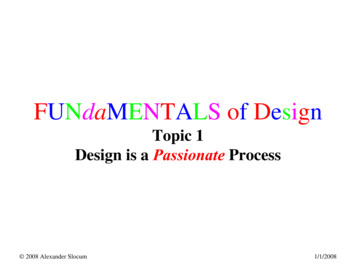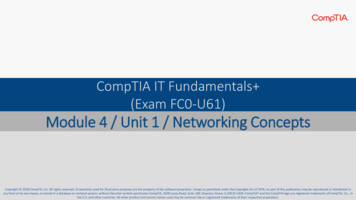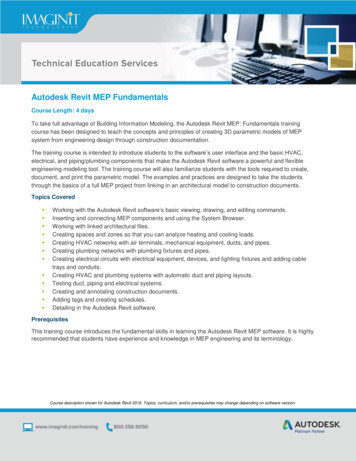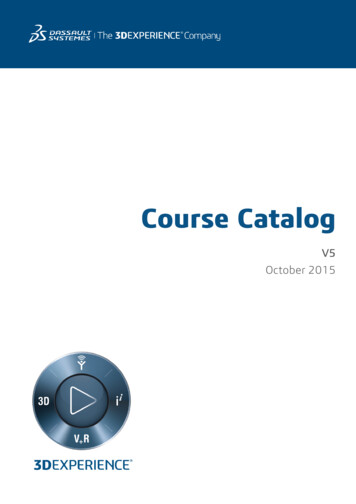
Transcription
FUNdaMENTALS of DesignTopic 1Design is a Passionate Process 2008 Alexander Slocum1-01/1/2008
Design is a Passionate ProcessLong before any design project starts, the designengineer has to believe that there is a problem that isworthy of their attention. The design engineer must feela need to solve the problem. The design engineer musthave a yearning to solve the problem. The design engineer must be passionate about solving the problem!However, one must be very careful about managing one’s passion, lest one’s excitedness overshadowstrue opportunity. In the world of business, it does notmatter if the design engineer passionately creates aproduct that does not meet customer needs. Passionmeans little if the design is tainted by ignorance andinattention to detail.This book is thus very much about exploringways to turn unstructured problems into FUNstructuredopportunities! Passion is a necessary, but not sufficient, component of a good design engineer’s effort tosolve a problem. Accordingly, this chapter introducesdesign as a passionate process to be carried out in acareful, systematic, deterministic manner catalyzed withrandom hyper adrenalin drivenof super creativity!burstsThe notion that design can be studied or implemented as a process may seem oxymoronic to many creative people. Indeed, any good “design process” shouldallow even the most complex design to be broken upinto manageable stages that encourage and catalyzefree-spirited creative thinking and deterministic analysis. During each stage, the design engineer can focus ona portion of the problem with an appropriate amount ofleft and right brain effort. For example, when envisioning a new vehicle, one need not be too concerned withbolt stresses; such details will come later in the detailphase.Most design processes typically involve repeatingessentially the same steps as the design funnels downfrom broad concepts to details. Once the designer learnsthe fundamentals of a process, they can easily apply itover and over again as the design evolves from the concept to the detail phase. A good design process shouldbe simple, flexible, and applicable to just about anyproblem one can think of.So read and study with Passion while thinking about how to design a better robot for your favoriterobot competition, or how to design a fun weekend!
Topic 1Design is a Passionate ProcessTopics: PassionDeterministic designSystematic Organization of IdeasDesign ProcessesMilestones 2008 Alexander Slocum1-11/1/2008
Design ContestsSince the 1960’s, sophomores in MIT’s Department of MechanicalEngineering have been taking the hands-on Introduction to Design course“2.70” (which evolved into course 2.007 in 1995). The course teaches the fundamentals of mechanical design process and machine elements via hands-onengineering challenges. Lectures assume students have done the reading (thisbook!) so they can focus on potential solutions to the homework design problems. The homeworks help guide the students the design and build a remotecontrolled machine for use in an end-of-term celebration (contest!).A new contest is created each year by students who have just completed the class, and they use the design process learned in class. About 10%of the previous year’s students become current year’s Undergraduate Assistants (UAs), who help run the class, and this helps generate a feeling of studentownership. Student participation is a key element in the design of good contests, for what teachers may think is most excellent, students may find boring.It is critical to incite students’ passion and sense of ownership, while providinga rich environment for teaching fundamental principles. It is also important forstudents and teachers alike to have fun!To help illustrate the principles and ideas presented in this text, the2002 MIT 2.007 design contest The MIT and the Pendulum will be used as acase study. In this type of design contest, the playing field has a variety ofobstacles and scoring methods, and students drive their radio controlledmachines in one-on-one contests to see who can score the most points.Put yourself into the mind of a student creating a machine for TheMIT and the Pendulum, which is of course a geek twist on Poe’s The Pit andthe Pendulum. The table is symmetrical with a scoring bin on each end and arigid pendulum on each side in the middle of the table. Each pendulum ismade from a square hollow plastic tube half-filled with blue street hockeyballs. Its center of gravity is below its pivot point both with or without theballs. On the table, there are also street hockey pucks and balls.The pendulums start hanging straight down in the middle of the designated starting area for each contest machine (robot). As shown, your score is afunction of the total mass of balls and pucks collected in the bins and the totalangular distance traveled on the pendulum. Each term of the scoring equationhas a small constant to increase the richness of potential winning strategies!The question is how to use the pendulum to your advantage, withoutyour machine getting bashed by the swinging pendulum? There are a lot ofballs in the pendulum and if it is swumg just right, the balls will empty andbounce into the end scoring bin.WhatWouldYouDo!?
Design Contests Theme: Multiple ways to score (mass and motion)“Rules”:–––Only use materials in the kit and plus fasteners and adhesivesMachine must fit into starting zone (0.5m x 0.5m x 0.5m cube) You can start with your machine engaged (wheels preloaded) to table features“Score” is evaluated at the end of 45 second contest:Score (θ cumulative rotation 1)–– (mtotal puck & ball mass in grams 100)You may not interfere with your opponent’s ability to score until you first score by getting apuck or ball into your scoring binYou may not damage the table or willfully damage your opponent No nets or entanglement devicesWhat would you do?––How would you go about designing and building a machine to participate?How would you balance your effort with all the other obligations you have?2003 contest: The 2 Tables 2008 Alexander Slocum2004 contest: The Big Dig2002 contest: The MIT & the Pendulum1-21/1/2008
Passion LOVE to CreateHistory is replete with examples of people who achieved extraordinary goals by means of their brilliance or sheer will, but rarely without passion.History is also replete with people who never accomplished much of anythingbecause they could never bring themselves to pry themselves away from mindnumbing inactivity. Designers usually are passionate about the concept generation aspects of design; however, details can often appear boring, but thedetails are every bit as important to a design as the overall concept if the goal isto bring to market a truly inspiring product.1 The difference in a product that isjust created verses one that is created with Passion is like the differencebetween a handshake and a honeymoon!The first step in developing a personal passion plan is to realize thatthat there are different orders of Passion as a catalyst for accomplishing agoal, ranging from the simple realization that a task needs to be accomplishedin order to pay the rent and buy food, to the realization that the idea on whichyou are working could change the world. The second step is to gauge the taskat hand and select an appropriate level of passion, for if one expects to save theworld by mowing the lawn, one may be in for a letdown. The third step is tothink of how you and others will benefit from what you are doing, and how biga "thank you!" you will get either now or in the future for accomplishing thetask. The fourth and perhaps most critical step is to think of your most desirousintellectual and physical activities, and realize that the task at hand can be ameans for you to better enjoy the things you love most!Just about any activity can be conducted in a manner that helps one togrow in the context of their goals in life both professional and personal. Withthis in mind, consider the some of the author’s fun functions:Most desirous intellectual activities: Designing and building new things,playing games, and solving puzzles Most desirous physical activities: Exercise, Snowboarding, SCUBA diving, triathlon.Physiologically, passion goes hand in had with the release of endorphins in the brain. Hence to feel good when doing details that may otherwisenot be big endorphin releasers, map the activities onto other activities that canhelp to stimulate endorphin release. Mental tasks can be mapped onto gamesand puzzles. While doing mental tasks, one can also incorporate light exercisewhich is a proven endorphin generator. Some activities, such as washingdishes or doing the laundry, require such a low level of brain activity that onecan do them while also designing new gadgets to help to accomplish the boringtask. Table 1 provides some examples.Table 1: Injecting passion into common activitiesActivityIntellectual MappingPhysical MappingBackground research: Creating alist of functional requirements,investigating what has beendone, conducting surveys.You are creating a treasure mapthat will lead you to the buriedtreasure (contained in the walletsof countless consumers!)Go for a walk and meet customers. Walk and observe othersusing competing products.Making drawings before makingstuff in the shopThis is a video game! As youdetail the parts imagine thembeing machined and assembled.Keep your eyes open for shortcuts to minimize the number ofparts and make them effortlesslysnap together in an obvious way.Create a dance that makes youthe part as it goes through themanufacturing process, and dothe dance. Walk through the factory imagining each step of themanufacturing process.Writing reportsCreate poems to describe ideas.Using the Nth, Mth letter ofeach page, create secret messages Do chair-based exercises andstretches (very important forhealth).Washing dishesHow can I design a self washingdish? How would I automatethis? What if I could read watermolecules’ memories?An opportunity to do calf andbalance exercises!“Curiosity, like coffee, is an acquired need. Just a titillation, at the beginning, it becomes with training a raging passion” Nicholas S. Thompson 1.Great insightful books about passionate designers include: Robert A. Lutz, Guts, John Wiley &Sons, New York; Ben Rich, SkunkworksImagine your robot zooming ahead to victory, AND the satisfaction you willget knowing that you engineered every aspect of your machine. You usedphysics to catalyze the creation of creative concepts, and your machine performed as predicted. It was built on time and on-budget! You now have thecapabilities and the confidence to conquer any task. You see yourself leadingthe Mars Lander design team Now, start thinking of strategies to win!
Passion LOVE to Create"Enthusiasm is one of the most powerful engines of success. When you do athing, do it with all your might. Put your whole soul into it. Stamp it withyour own personality. Be active, be energetic, be enthusiastic and faithful andyou will accomplish your object. Nothing great was ever achieved withoutenthusiasm"Ralph Waldo Emerson Use Passion as a catalyst to make ideasbecome reality:– Never stop asking: “Is this really the best I can do” “Can the design be made simpler”– Create, never stagnate– Do you see machines in ink blots?Ink-Blot milling machine by Peter How 2008 Alexander Slocum1-31/1/2008
Passion Focus!The “F word” inspires fear in many people, because it means that theywill have to control their wild ways and learn to FOCUS. The ability to focuson a problem helps one create a good working solution in an appropriateamount of time using an appropriate amount of resources. The words elegantand efficient come to mind when one thinks of an engineer who has focused onand finished a problem. Just as the optical term implies, focusing on a problemmeans to define a field of view, clearly see what needs to be done, and then doit in depth! Engineers are typically given poorly defined problems else theywould not be problems. Some guidelines to help focus include: Maximize aquatic avian linearity: Get your ducks in a row Dissect the problem into its components and requirementsMaximize avian termination with a minimum number of projectiles: Kill two birds with one stone Systematically generate solution strategies and machine concepts Look for similarities between elements of the problemLacerate bovine growth by-product: Cut through the bulls#!t: Identify the primary tasks that must be completed to succeed Establish a set of goals and work efficiently to meet them Avoid fluff and beware of productivity perils and endless discussions without resolutionsMinimize deceased equine flagellation: Do not beat a dead horse Learn to recognize when an idea is destined to be intractablegiven your allowable resources, and then drop it Keep your ego in check, and learn to put your failures on thefront page next to your successesImpactus maximus ad gluteus maximus: Give the project a BIG kick in the butt and do not delay starting! Maintain momentum and strive to finish ahead of schedule! Help others to get focusThe design of anything, from machines to software to prose, followsthe same types of guidelines1. So be on the lookout for how you can applythese guidelines to other things you do. Your mind is a giant bio neural net,just waiting for new connections to be made! Just think of Mick Jagger, KeithRichards and Henry Maudslay! Their maxims will be with us forever!Creative people often have a difficult time focusing, because as soonas they convince themselves that an idea they are working on is doable, theyare often easily distracted by some other wonderful opportunity that arises.Given that many of us are required to work on several projects simultaneously,or to take several courses, focusing can be just as difficult. It requires willpower, pure and simple. It is just one of those things you have to learn to do;therefore, learn to say the "F word" to yourself. FOCUS! When you focus,then the other fun "F words" will also be yours: "Finish" and "Fun" and thatgreat 4 letter "F word" expression, "Free time"!Take a careful look at the contest table and play with it, either physically or in your mind. Think about the ways to score, their apparent difficulty,and the potential for a simple means to dominate each scoring method. Consider your commitments to other activities, and determine how much time youwill actually have to spend on your robot. Next, carefully apportion that timeto different phases of the design process (strategizing, conceptualizing, detailing, building, testing). Within each phase, think about creating a clear set ofgoals towards which you will efficiently work; AND maintain constant vigilance against things that would have you detract from your goals. Always havea simple alternate path to take should you end up in the woods!1.From “Politics and the English Language” George Orwell, 1946, .txt:a Never use a metaphor, simile or other figure of speech which you are used to seeing in print.b Never use a long word where a short one will do. (iii) If it is possible to cut a word out,always cut it out.c Never use the passive where you can use the active.d Never use a foreign phrase, a scientific word or a jargon word if you can think of an everyday English equivalent.e Break any of these rules sooner than say anything outright barbarous.
Passion FOCUS!Keep Your Eye on the Prize“You can’t always get what you wantBut if you try sometimes well you might findYou get what you need”Mick Jagger & Keith Richards etitbleed.txtHenry Maudslayfrom J. Roe English andAmerican Tool Builders, 1916 Yale University PressGet a clear notion of what you desire to accomplish, then you will probably get itKeep a sharp look-out upon your materials: Get rid of every pound of materialyou can do without. Put yourself to the question, ‘What business has it there?’Avoid complexities and make everything as simple as possibleRemember the get-ability of partsHenry Maudslay’s Maxims (1700’s, a father of modern machine tools)Maudslay’s screw cutting lathefrom J. Roe English and American Tool Builders, 1916 Yale University Press 2008 Alexander Slocum1-41/1/2008
Deterministic DesignEverything happens for a reason, and we merely need to apply theproper resources and focus in order to discover and understand the issues thatwould otherwise lead to uncertainty. Minimizing uncertainty, and hence risk,makes a design more deterministic. Deterministic design1 can be facilitatedthrough the use of a structured design process. While it might be possible todebate whether design itself is a deterministic or stochastic (shoot-from-thehip) process, it is best to focus creative and analytical forces on real designproblems in order to stay on the schedule.Engineering design problems are essentially cost and performancetrade-offs, and a key element of performance is time to market. It does notmatter how good your solution is if you miss the market window. Consequently, engineers with a vibrant passion for success live on the (appropriate)edge. Because the edges move as cost/performance requirements change,engineers and managers must remain nimble, open-minded, and on continuallookout for disruptive technologies2 that can deliver far more performance forfar less cost (e.g., integrated circuits verses vacuum tubes).The stagnant edge is the realm of the complacent engineer who isasking a competitor to come and take away market share and the business. Alltoo often an engineer gets good at doing something and then fails to realize thatnew methods have been developed that can provide better performance for lesscost. This is akin to riding on the flat bottom of your snowboard while gazingat the sky. You are asking for a face plant or a tree hug!The leading edge is the place to be as it means that it is very difficultfor a competitor to do better than you unless they spend a lot of resources, andyou are likely doing better than all your competitors. The leading edge canonly be maintained by constant vigilance and being ready to switch to a different technology curve. This is akin to switching between the toe and heel edgeof your snowboard as you weave your way through the woods.1.R. Donaldson, “The Deterministic Approach to Machining Accuracy”, SME FabricationTechnology Symposium, Golden, CO, Nov. 1972 (UCRL preprint 74243).2.Clayton M. Christensen, The Innovator’s Dilemma, 1997 Harvard Business School press, Boston,MA. USAThe bleeding edge3 is the place for paranoid engineers who refuse tochange their ways and instead think that with just a little more effort, thingswill work out; however, soon they run out of resources and fail. Creative solutions may appear to be more clever than solutions arrived at by analyticalmeans; however, if analysis was not applied, it is likely that the solution restson the bleeding edge. This is akin to the snowboarder who refuses to turnbecause the hill is too steep, and instead runs off into the woods. Time aftertime, it is shown that individuals or teams who can simultaneously harness thepower of creative and analytical and computational methods outperform thosewho use less than all three. Only then can you consistently identify the slopewith the finest possible powder and then make first tracks!Consider the evolution of the machines on which your parts willlikely be produced. Linear actuators are key elements that determine thespeed, accuracy and force with which the axes move. Sliding contact leadscrews worked great for over a hundred years until they gave way toballscrews which are starting to give way to linear electric motors. Each succeeding technology costs more than the other but provides better performance.However, for the new growth area of small machine tools to make mesoscopic(cm3 sized) parts, large forces and strokes are not needed. DC voice coil actuators have all the advantages of linear electric motors yet do not require expensive commutation circuits; thus they can have lower cost and higherperformance. Understanding the physics of the problem and the scaling laws iscritical!Create a table of the basic physical properties and capabilities of thekit parts, and a spreadsheet to study time, motion, power required to score byeach different means. Forecast what might be easy and what would be difficultways to score, and think of strategies and concepts for ideas that are not easy,yet not too difficult. Then think of strategies and concepts for the more challenging scoring methods!3.The term bleeding edge was coined by Richard W. Slocum III, a gifted project manager anda key catalyst in the life of his little brother who is eternally grateful for the butt kickings hereceived that enabled all you are reading to come to be. Thanks Rick for keeping me focussed!
Deterministic Design Everything has a cost, and everything performs (to at least some degree)– If you spend all your time on a single tree, you will have no time for the forest– If you do not pay attention to the trees, soon you will have no forest!– You have to pay attention to the overall system and to the details Successful projects keep a close watch on budgets (time, money, performance)– Do not spend a lot of effort (money) to get a small increase in performance “Bleeding edge” designs can drain you!– Do not be shy about taking all the performance you can get for the same cost! Stay nimble (modular!) and be ready to switch technology streams– It is at the intersection of the streams that things often get exciting!– “If you board the wrong train, there’s no use running along the corridor in theopposite direction” Dietrich Bonhoeffer 2008 Alexander Slocum1-51/1/2008
Deterministic Design: Play An engineer or a team with focus can follow a natural progression ofevents and they will likely be successful. A large part of the process willrequire the engineers to fully immerse themselves in the development of thesolution. In the case of a mechanical problem to be solved, this often means alot of physical play. In the case of a software problem to be solved, virtual playrules! In all cases, just as we learned as children by playing, playing continuesto be a very important part of the adult learning process. Playing with problems and available resources enabled humans’ brains toevolve. Play involves all the senses, and as they send signals to our brains,our bio neural nets are activated, and the ideas begin to flow: Look at the problem and resources available to you: Create mental 3D images and movies of the problem and manipulate them in your mind so your bio neural net can work on solutions while you do the laundry. Touch the parts of problem and resources available to you: The weight and size and feel of the physical elements enters yourneural net through your fingers and you become one with thehardware so you can better imagine the actual physical responseof the system. Listen to the sounds that are associated with the problem and theresources: Patterns in sound often give rise to identifying the true performance of a system. Smell the problem and resources to build a better actual bio neural virtual net model of the challenge. Taste victory (or the resources if this is a food-based challenge) byimagining your solution is the one that wins!Sketching the problem and possible solution strategies and concepts ishow we communicate with others, including ourselves: Sketch the problem so you can look at it from different perspectives. Sketch possible solution strategies and concepts so you can tape themto the wall and scan them all simultaneously and search for strengthsand weaknesses.Modeling the problem and possible solution strategies and conceptsallows you to better play and develop and evolve solutions: Simple physical models allow you to better play with the system andthey often help to identify the system’s most sensitive parameters. Analytical models can allow you to identify the most sensitive parameters of the problem and help guide your solution path: Analytical models can identify equine orientation BEFORE youhitch your wagon to them (and then try to beat them to move). Analytical models can enable you to optimize your solution tominimize cost and effort. Analytical models allow others to understand your intent.Detailing the solution before you build can help identify minute yet critical features that may otherwise cause failure: Bolt holes should be drawn so you can envision how the system willbe assembled. Every little chamfer need not be put in if you are creating a benchlevel prototype.Building and testing your solution is the physical realization of all that youhave worked so hard to achieve: Like ourselves, most things have to evolve, so finish early and be yourown toughest customer! If you were continually assessing risk and planning countermeasures,if tests reveal a problem, you will be more likely to recover.Following pages will systematically describe a design process thatcan be a useful catalyst to help you develop your ideas.Play with the contest table and the kit parts. Sketch the different operating conditions of the table and animate them in your mind to see what mightbe most easily exploited. Make a solid model of the table and collect solidmodels of the kit parts. Use the solid model of the table to acquire mass andinertia properties and combine these with the power of the motors to get anidea of what might be achievable in the allotted contest time. Create some simple physical models that allow you to better play with the table and to help youbetter identify scoring opportunities and develop elegant strategies. Thinkahead about how much detail will be required to realize your strategies, anddetermine if you have the resources to actually build and then test your solution. Update your web page (as you should do every time you have a significant advance. No more reminders will be given, you all are big geeks now).
Engineering is often a tactile, visual, verbal, cerebral, and physical activity:ccess!Play with the table and the kit partsSketch ideasCreate physical & analytical models to identify opportunities and test possible strategiesDetail the machine using all the engineering skills and tools at your disposalBuild & test your machine!“Personal self-satisfaction is the death of the scientist. Collective self-satisfaction is thedeath of the research. It is restlessness, anxiety, dissatisfaction, agony of the mind thatnourish science” Jacques-Lucien MonodMartin Jonikas' high scoring machine and idea evolution.Can you figure out how it works (Reverse Engineering)and create an even better machine?––––––!SuDeterministic Design: Play! 2008 Alexander Slocum1-61/1/2008
Deterministic Design: Analytical Instinctto your problem already exists, and all you have to do is tune your mind to thecosmic ether in order to find it!How do some great design engineers just seem to “know” what to do?How can some people just pour out the analysis while others must strugglewith every single formula? Are some people just born with what it takes? Aresome people funda-bio-mentally incapable of being creative or power geeky?There is no doubt that some people have a knack or are just plain gifted withrespect to creative or analytical thought. They have an instinct that is hard tomatch; however, there are ways in which you can develop your ability to bemore creative or analytical.Recognize what your strong points are, and keep exercising them sothey remain strong; however, you must also specifically recognize your weakpoints and work to make them strong! then, randomly think in a manner opposite to that which is your norm. You should force yourself to consider theopposite of what you are thinking (as long as they are nice thoughts!). Thestress of forcing yourself to think and then think different is a good thing!1The first thing that you must do is learn to trust your instincts, andthen to purposely thwart them. When you are presented with a problem, dojust what your instincts tell you to do and approach the problem from either avisual, creative, wild, far-out, zany, draw-and-play perspective; OR carefullyanalyze the situation and create an analytical model from which you can predict the best answer.AND THEN DO THE OPPOSITEIf you first approached the problem from a creative aspect, forceyourself to carefully systematically analyze your creative thoughts. Writedown in words the physics that describes the problem and your solution. Writedown or develop the equations that can model the problem and your solution.Study the analysis and look for the “fat rabbit variables”. If you were starvingand had to hunt to survive, you would not waste your time hunting the thin fastrabbits, you would go after the slow plump ones! Life is a Jacobean, so startdifferentiating amongst the variables to determine the sensitive regions onwhich you should focus your effort!If you first approached the problem from an analytical perspective,which is actually no less creative in many respects than a wild visual foray,then it is time to raise your shirt and contemplate your belly button! Pull outthe lint and instead of determining how much more you need to knit a sweater,contemplate the cosmos and what combination of fundamental particles hasformed somewhere in the universe to solve your exact problem! An infiniteexpanse of an infinite number of particles means that somewhere the solutionFor example, in the Pass the Puck 2.007 contest at MIT there was abarrier between two sides of the table, and the goal was to move balls andhockey pucks from your side of the table to the opponents side of the table.The barrier was difficult to climb, and some students had the bright idea of creating a platform from which their vehicle could zoom over to
book!) so they can focus on potential solutions to the homework design prob-lems. The homeworks help guide the students the design and build a remote controlled machine for use in an end-of-term celebration (contest!). A new contest is created each year by students who have just com-pleted the class, and th










